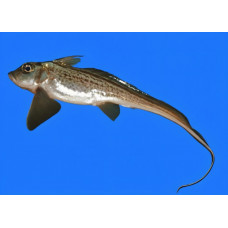Latin name
Chimaera monstrosa
Other name
Rat fish
Identification
The head of the rabbit fish is thick with a rounded snout. The eyes are large. The mouth is lower, small and transverse. The upper jaw has 4 and the lower jaw has 2 large beak-shaped tooth plates. The body is elongated, thinning strongly behind. The narrow bicoid tail ends in a long filament. There is a system of sensory canals on the head. The skin is bare and soft, occasionally covered with rudimentary spines. Males have a thin bony projection between the eyes that curves forward.
Features of fish fins
The pectoral fins of this fish are very large. The first dorsal fin is high and short, with a strong, long spike on the leading edge; the second dorsal fin has a low edge that extends to the beginning of the caudal fin. The anal fin is small.
Fish colouring
The coloration of the dorsal surface of the rabbit fish is dark brown with a reddish tinge, the sides are covered with spots, the ventral side is bright. The caudal, anal, and posterior parts of the second dorsal fins have a blackish-brown edge. The skin of males is smooth and shows a variety of colors.
Distribution
This species is widespread in the North Atlantic and adjacent seas of the Arctic Ocean. It is found off the coasts of Norway, Iceland, Ireland, the United Kingdom, France, Italy, Portugal, Morocco, the Azores and Madeira, and the Mediterranean Sea.
Habitat
This marine, bathydemersal, oceanodromous fish is found at depths from 40 to 1400 m. In the north it is most often found at depths of 200-500 m, and in the south at 350-700 m. In the winter it moves closer to the coast. At this time it is caught in Norwegian fjords at depths of 90-180 m.
Size
Adult chimeras reach a length of 1.5 m and a maximum recorded mass of 2.5 kg. Juveniles are 11 cm long. Males are generally smaller than females.
Behavior
Juvenile rabbit fish are rarely caught. It is known to be caught off the Faroe Islands at a depth of 1000m and off Ireland at a depth of 600m.
Food and feeding habits
Bentophagous. Their diet consists mainly of invertebrates: crustaceans, mollusks, worms and echinoderms. Fish are sometimes found in their stomachs.
Reproduction
This species lays eggs enclosed in a horn capsule. Reproduction occurs throughout the year. Up to 200 eggs develop in the ovaries of the female. The female lays two eggs each several times without re-fertilization. Before laying, the female carries the eggs attached to the oviducts. She then deposits them on the seabed at relatively deep depths, sometimes up to 400 meters. The yolk is 26 mm in diameter. The capsule has a fin-like edge up to 4 mm high. The lower end of the capsule is cylindrical, the upper end has the appearance of a narrow thread-like appendage that serves to attach the egg. The capsule is 163-77 mm long and about 25 mm wide. The length of the appendage is 30-40 mm. The capsule is shiny brown to olive green. Eggs develop for about a year. Newborns hatch fully formed.
Fishing
The rabbit fish is not a commercial fish, but there are cases of it being caught intentionally. It is often caught as by-catch in bottom trawls when fishing for other fish.
Relationship with a person
Traumatogenic. The flesh of this fish is tough, but it is eaten in some countries.
| Classification | |
| Phylum | Chordata |
| Class | Chondrichthyes |
| Squad | Chimaeriformes |
| Family | Chimaeridae |
| Genus | Chimaera |
| Species | C. monstrosa |
| Features | |
| Conservation status | Vulnerable |
| Habitat | Pelagic |
| Life span, years | No information |
| Maximum body weight, kg | 2,5 |
| Maximum length, cm | 150 |
| Sailing speed, m/s | No information |
| Threat to people | Edible |
| Way of eating | Bentophage |
Rabbit fish
Tags: rabbit fish

